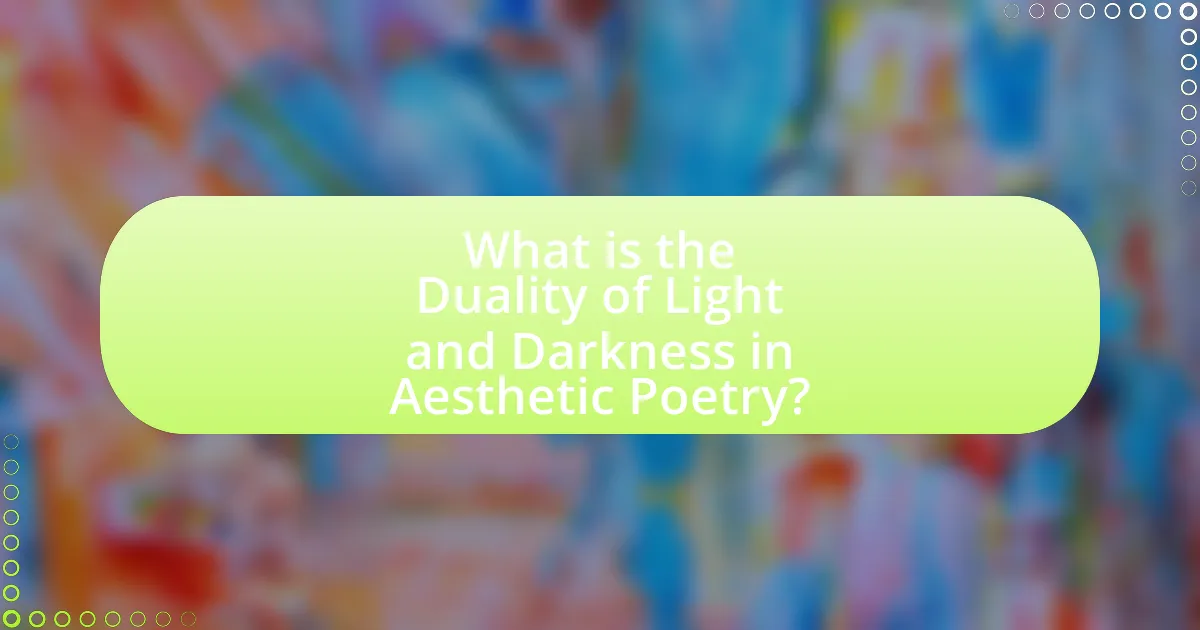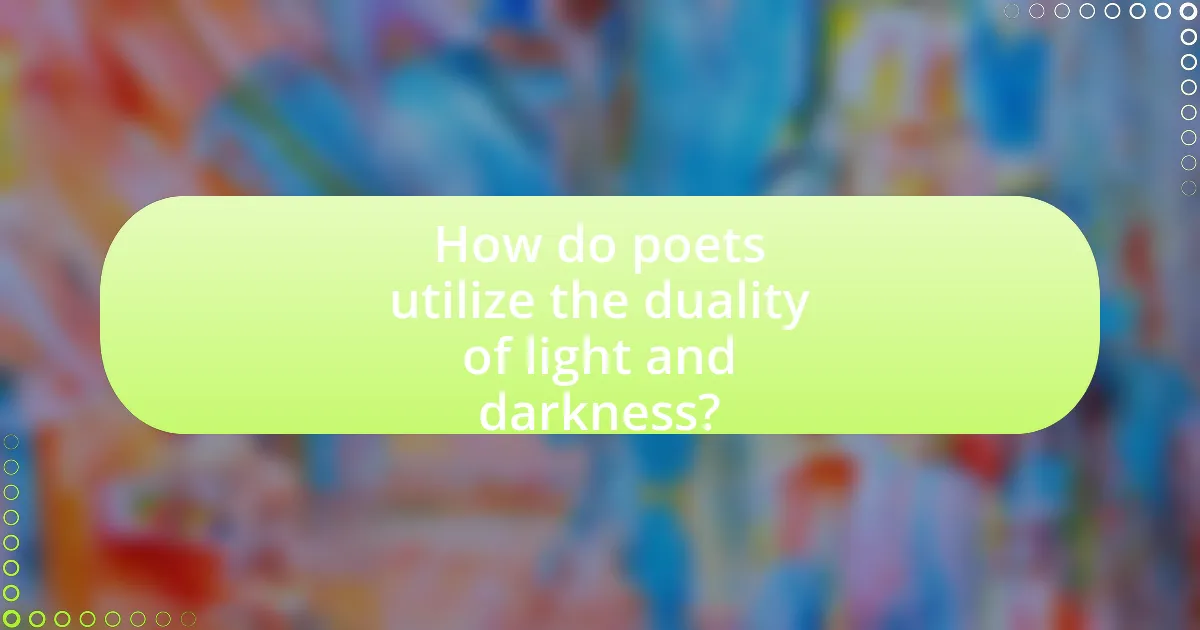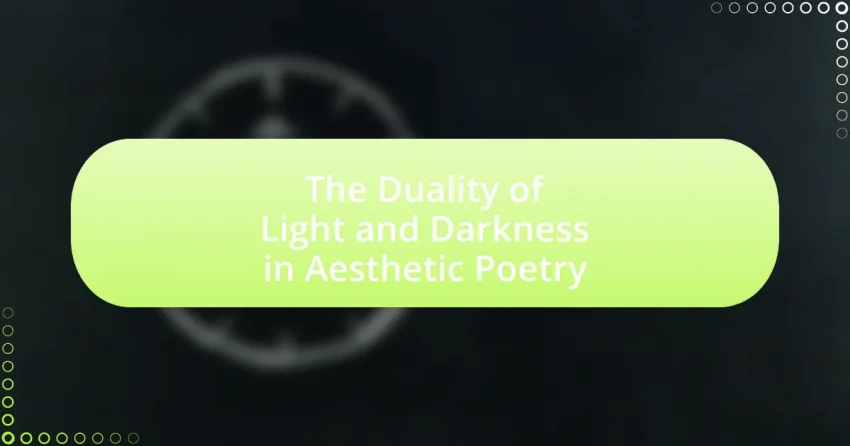The article examines the duality of light and darkness in aesthetic poetry, highlighting how these contrasting themes symbolize complex human emotions and experiences. It explores the significance of light as a representation of hope, clarity, and beauty, while darkness embodies despair, confusion, and the unknown. The discussion includes notable poets such as John Milton and William Blake, who effectively utilize this duality to enhance thematic depth and emotional resonance in their works. Additionally, the article addresses the cultural contexts that shape interpretations of light and darkness, the psychological effects on readers, and specific examples of poems that exemplify this duality.

What is the Duality of Light and Darkness in Aesthetic Poetry?
The duality of light and darkness in aesthetic poetry represents the contrasting themes of hope and despair, enlightenment and ignorance, often reflecting the complexities of human experience. This duality serves as a powerful metaphor, where light symbolizes clarity, truth, and beauty, while darkness embodies confusion, fear, and the unknown. Poets utilize this interplay to evoke emotional responses and explore the depths of existence, as seen in works by authors like John Milton and William Blake, who intricately weave these themes into their narratives. The effectiveness of this duality is evidenced by its prevalence in literary traditions across cultures, highlighting its universal significance in understanding the human condition.
How do light and darkness symbolize different themes in poetry?
Light and darkness symbolize contrasting themes in poetry, representing concepts such as hope versus despair, knowledge versus ignorance, and life versus death. For instance, light often signifies enlightenment, purity, and optimism, while darkness can embody confusion, evil, and sorrow. This duality is evident in works like William Blake’s “The Lamb,” where light symbolizes innocence, and “The Tyger,” where darkness represents the fearsome aspects of creation. Such symbolism allows poets to explore complex emotional landscapes and moral dilemmas, enhancing the depth of their themes.
What emotions are commonly associated with light in aesthetic poetry?
Emotions commonly associated with light in aesthetic poetry include joy, hope, purity, and enlightenment. These emotions arise from light’s symbolic representation of positivity and clarity, often contrasting with darkness, which embodies despair and confusion. For instance, poets frequently use light to evoke feelings of warmth and optimism, as seen in works that celebrate dawn or sunlight, illustrating the transformative power of illumination in human experience.
What emotions are commonly associated with darkness in aesthetic poetry?
Emotions commonly associated with darkness in aesthetic poetry include despair, melancholy, fear, and introspection. These emotions are often explored through imagery and themes that evoke a sense of loss or existential dread. For instance, poets like Edgar Allan Poe and Emily Dickinson frequently utilize dark motifs to convey feelings of isolation and sorrow, illustrating how darkness can serve as a backdrop for deep emotional exploration. This connection between darkness and complex emotional states is a recurring element in aesthetic poetry, reinforcing the idea that darkness can illuminate the human experience by highlighting vulnerability and depth.
Why is the interplay of light and darkness significant in poetic expression?
The interplay of light and darkness is significant in poetic expression because it symbolizes contrasting emotions and themes, allowing poets to explore the complexities of human experience. This duality serves as a powerful tool for conveying feelings such as hope and despair, joy and sorrow, or clarity and confusion. For instance, in literature, light often represents knowledge, purity, and life, while darkness can signify ignorance, evil, and death. Poets like William Blake and Emily Dickinson have effectively utilized this interplay to deepen the emotional resonance of their work, illustrating how light and darkness coexist and influence one another. This dynamic relationship enriches the thematic depth of poetry, making it a vital aspect of aesthetic expression.
How does this duality enhance the depth of poetic imagery?
The duality of light and darkness enhances the depth of poetic imagery by creating contrasting elements that evoke complex emotions and vivid mental pictures. This contrast allows poets to explore themes of hope and despair, beauty and ugliness, or knowledge and ignorance, enriching the reader’s experience. For instance, in aesthetic poetry, light often symbolizes purity and enlightenment, while darkness can represent mystery and the unknown. This interplay invites readers to engage with the text on multiple levels, as they navigate the emotional landscape shaped by these opposing forces. Such duality is evident in works like John Keats’ “Ode to a Nightingale,” where the juxtaposition of light and dark imagery deepens the exploration of mortality and transcendence.
What role does contrast play in the reader’s interpretation of poetry?
Contrast plays a crucial role in shaping the reader’s interpretation of poetry by highlighting differences that evoke emotional responses and deepen understanding. By juxtaposing opposing elements, such as light and darkness, poets create tension and complexity, allowing readers to explore themes more profoundly. For instance, in John Keats’ “Ode to a Nightingale,” the contrast between the ephemeral nature of life and the eternal beauty of art enhances the poem’s exploration of mortality and transcendence. This use of contrast not only enriches the imagery but also invites readers to engage with the underlying meanings, making the experience of poetry more impactful and layered.

How do poets utilize the duality of light and darkness?
Poets utilize the duality of light and darkness to explore contrasting themes such as hope and despair, joy and sorrow, and knowledge and ignorance. This juxtaposition allows poets to create a rich emotional landscape, where light often symbolizes positivity, clarity, and enlightenment, while darkness represents negativity, confusion, and mystery. For instance, in John Milton’s “Paradise Lost,” light is associated with divine presence and goodness, whereas darkness embodies chaos and evil. This duality not only enhances the thematic depth of their work but also engages readers by prompting them to reflect on the complexities of human experience.
What techniques do poets employ to convey this duality?
Poets employ techniques such as imagery, symbolism, and juxtaposition to convey the duality of light and darkness. Imagery allows poets to create vivid representations of both elements, enabling readers to visualize and emotionally connect with the contrasting themes. Symbolism assigns deeper meanings to light and darkness, often representing concepts like hope and despair, respectively. Juxtaposition places these opposing elements side by side, highlighting their differences and enhancing the tension between them. For example, in John Milton’s “Paradise Lost,” light symbolizes divine presence while darkness represents chaos, effectively illustrating the duality within the narrative.
How does metaphor function in expressing light and darkness?
Metaphor functions in expressing light and darkness by creating vivid imagery that conveys complex emotional and philosophical ideas. In aesthetic poetry, light often symbolizes knowledge, purity, and hope, while darkness represents ignorance, despair, and fear. This duality allows poets to explore the contrasts between enlightenment and obscurity, facilitating deeper understanding of human experiences. For example, in John Milton’s “Paradise Lost,” light signifies divine presence and truth, whereas darkness embodies chaos and sin, illustrating how metaphor enriches the thematic depth of the work.
What role does imagery play in illustrating the duality?
Imagery serves a crucial role in illustrating the duality of light and darkness in aesthetic poetry by creating vivid contrasts that evoke emotional responses. Through specific visual descriptions, poets can depict light as a symbol of hope, purity, and enlightenment, while darkness often represents despair, ignorance, and fear. For example, in works like William Blake’s “The Tyger,” the imagery of the fierce tiger juxtaposed with the innocence of the lamb highlights the coexistence of good and evil. This use of contrasting imagery not only enhances the thematic depth but also allows readers to engage with the complexities of human experience, reinforcing the idea that light and darkness are interdependent forces within the poetic narrative.
In what ways do cultural contexts influence the representation of light and darkness?
Cultural contexts significantly influence the representation of light and darkness by shaping the symbolic meanings attributed to these elements. For instance, in Western cultures, light often symbolizes purity, knowledge, and goodness, while darkness is associated with evil, ignorance, and fear, as seen in literary works like John Milton’s “Paradise Lost.” Conversely, in many Eastern cultures, such as in Taoism, light and darkness are viewed as complementary forces, representing balance and harmony, which is evident in the concept of yin and yang. These differing interpretations are rooted in historical, religious, and philosophical beliefs that dictate how societies perceive and utilize the imagery of light and darkness in their artistic expressions.
How do different cultures interpret light and darkness in their poetry?
Different cultures interpret light and darkness in their poetry as symbols of duality, often representing knowledge and ignorance, hope and despair, or life and death. For instance, in Western literature, light frequently symbolizes purity and enlightenment, while darkness often conveys evil or ignorance, as seen in works like John Milton’s “Paradise Lost.” Conversely, in Eastern traditions, such as in Chinese poetry, light can represent clarity and truth, while darkness may embody mystery and the unknown, reflecting a more nuanced understanding of these concepts. This duality is evident in the works of poets like Li Bai, who often juxtaposes light and dark to explore the complexities of human experience.
What historical events have shaped the themes of light and darkness in poetry?
The themes of light and darkness in poetry have been significantly shaped by historical events such as the Enlightenment, the Romantic movement, and the World Wars. The Enlightenment, which emphasized reason and individualism, led poets to explore the contrast between enlightenment (light) and ignorance (darkness), as seen in the works of poets like John Milton and William Blake. The Romantic movement further deepened this duality, as poets like William Wordsworth and Samuel Taylor Coleridge used light and darkness to express emotional depth and the sublime, often reflecting societal upheavals and the Industrial Revolution’s impact on nature. Additionally, the World Wars introduced themes of despair and hope, with poets like Wilfred Owen and T.S. Eliot using light and darkness to convey the horrors of war and the search for meaning in a fractured world. These historical contexts provide a framework for understanding how light and darkness have been employed to express complex human experiences in poetry.
What are the effects of light and darkness on the reader’s experience?
Light and darkness significantly influence the reader’s experience by shaping emotional responses and thematic interpretations. Light often evokes feelings of hope, clarity, and positivity, while darkness can elicit emotions such as fear, uncertainty, and introspection. For instance, in aesthetic poetry, the juxtaposition of light and darkness can enhance the depth of themes, allowing readers to explore complex emotions and contrasting ideas. Research indicates that exposure to light can improve mood and cognitive function, while darkness can lead to a heightened sense of mystery and contemplation, as seen in works by poets like William Blake and John Keats, who effectively utilize these elements to engage readers on multiple levels.
How does the duality impact the emotional response of readers?
The duality of light and darkness significantly impacts the emotional response of readers by creating a complex interplay of contrasting feelings. This contrast evokes a deeper emotional engagement, as readers navigate the tension between hope and despair, joy and sorrow. For instance, in aesthetic poetry, the juxtaposition of light imagery with dark themes can amplify the emotional weight of the text, leading to a more profound resonance with the reader’s own experiences. Research indicates that such dualities can enhance emotional arousal and empathy, as readers relate to the multifaceted nature of human emotions, thus enriching their overall reading experience.
What psychological effects can light and darkness evoke in readers?
Light and darkness evoke distinct psychological effects in readers, influencing emotions and perceptions. Light often symbolizes hope, clarity, and positivity, leading to feelings of comfort and safety, while darkness typically represents fear, uncertainty, and despair, which can evoke anxiety or introspection. Research indicates that exposure to light can enhance mood and cognitive function, as seen in studies showing that bright environments can increase serotonin levels, promoting a sense of well-being. Conversely, darkness can trigger the fight-or-flight response, heightening alertness and emotional intensity, as evidenced by psychological studies linking dark imagery to themes of danger and the unknown. These contrasting effects shape the reader’s emotional journey and engagement with the text, reinforcing the thematic depth of aesthetic poetry.
How does the duality influence the overall mood of a poem?
Duality significantly influences the overall mood of a poem by juxtaposing contrasting elements, such as light and darkness, which creates emotional complexity. This interplay allows poets to explore themes of conflict, balance, and resolution, thereby enriching the reader’s experience. For instance, in aesthetic poetry, the contrast between light and darkness can evoke feelings of hope and despair simultaneously, leading to a more profound emotional resonance. The use of duality not only enhances the thematic depth but also engages the reader’s imagination, prompting them to reflect on the nuances of human experience.
What are some notable examples of this duality in famous poems?
Notable examples of the duality of light and darkness in famous poems include “The Road Not Taken” by Robert Frost, which contrasts choices and their consequences, and “Do Not Go Gentle into That Good Night” by Dylan Thomas, which explores the struggle against death. In Frost’s poem, the imagery of light represents clarity and understanding, while darkness symbolizes uncertainty and regret. Thomas uses light to signify life and vitality, contrasting it with the darkness of death, emphasizing the human desire to resist the inevitable. These poems illustrate the complex interplay between opposing forces, showcasing how light and darkness shape human experience and emotion.
Which poets are renowned for their exploration of light and darkness?
William Blake and John Keats are renowned for their exploration of light and darkness in their poetry. Blake’s works, such as “The Marriage of Heaven and Hell,” delve into the duality of existence, contrasting innocence and experience, which symbolizes light and darkness. Keats, in poems like “Ode to a Nightingale,” reflects on the interplay of beauty and mortality, often using light as a metaphor for transient beauty and darkness for the inevitability of death. Their contributions highlight the thematic significance of light and darkness in aesthetic poetry, illustrating complex emotional and philosophical landscapes.
What specific poems exemplify the duality of light and darkness effectively?
“Darkness” by Lord Byron and “The Road Not Taken” by Robert Frost exemplify the duality of light and darkness effectively. In Byron’s “Darkness,” the poem explores themes of despair and the absence of light, portraying a world engulfed in darkness, which symbolizes hopelessness. Conversely, Frost’s “The Road Not Taken” reflects on choices and their consequences, using light as a metaphor for clarity and understanding, while the darker path represents uncertainty and regret. Both poems illustrate the complex interplay between light and darkness, highlighting the emotional and philosophical dimensions of human experience.
How can readers appreciate the duality of light and darkness in their own writing?
Readers can appreciate the duality of light and darkness in their own writing by consciously exploring contrasting themes and emotions within their narratives. This approach allows writers to create depth and complexity, as seen in works like Shakespeare’s “Macbeth,” where light symbolizes ambition and darkness represents moral decay. By juxtaposing these elements, writers can evoke a richer emotional response from their audience, enhancing the overall impact of their work. Engaging with this duality encourages a more nuanced understanding of human experience, as demonstrated in the poetry of John Keats, who often intertwined beauty and despair to reflect life’s complexities.
